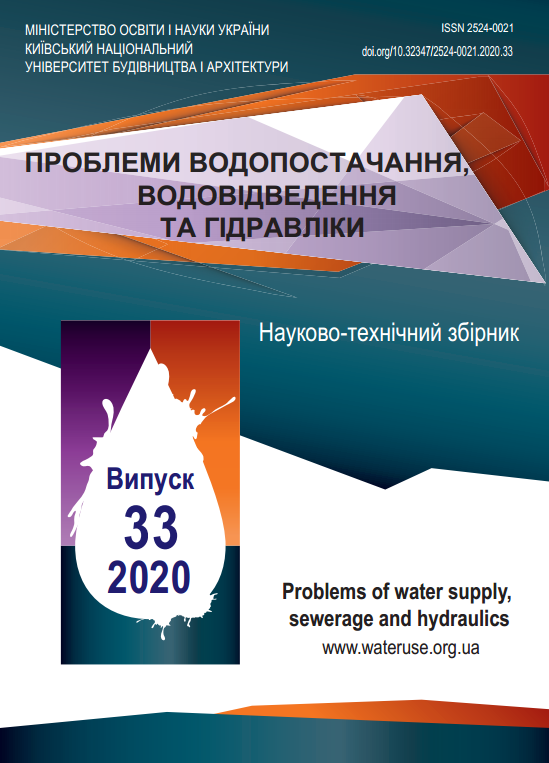Solving problems of local treatment of industrial wastewater from antibiotics
DOI:
https://doi.org/10.32347/2524-0021.2020.33.41-49Ключові слова:
wastewater treatment, antibiotics, pharmaceutical company, aluminum sulfate, cefuroxime, iron sulfateАнотація
The technology of local wastewater treatment from antibiotics is presented. It based on the consistent use of physico-chemical treatment methods and allows to remove antibiotics and related substances from wastewater to the requirements of regulations and divert treated wastewater into the municipal sewerage system. Model solutions of cefuroxime, a cephalosporin antibiotic, in distilled water with a concentration of 25 and 35 mg/dm3 were used for the study. Chemical oxygen demand model solutions, which is, respectively, 90 and 120 mg/dm3. The effect of reducing the chemical oxygen demand in coagulation and settling of wastewater in the case of the use of ferrous sulfate III was 79.2% and 75%, which is 4.2…6.7% higher than when using aluminum sulfate. The change of the chemical oxygen demand indicator of wastewater of the pharmaceutical enterprise according to the stages of their purification is established: "aeration – coagulation with ferrous sulfate III – settling – oxidation – filtration". After filtration, the effect of reducing the chemical oxygen demand was 95.8…100% at initial values of 120 and 90 mg/dm3, respectively. The technology of local wastewater treatment from antibiotics has been developed. It based on the consistent use of physico-chemical treatment methods and allows to remove antibiotics and related substances from wastewater to regulatory requirements and divert treated wastewater into the municipal sewerage system. The use of the developed technology of local wastewater treatment by antibiotics and related substances will lead to the requirements of industrial wastewater discharge into the municipal sewerage system, to significantly reduce the risk of antibiotics on the microorganisms of activated sludge biological treatment plants of the city, to reduce operating costs permissible discharges of wastewater into a natural reservoir.Посилання
Angeles L. F., Mullen R. A., Huang I. J., Wilson C., Khunjar W., Sirotkin H. I., McElroy A. E., & Aga D. S. (2020). Assessing pharmaceutical removal and reduction in toxicity provided by advanced wastewater treatment systems. Environmental Science: Water Research and Technology, 6(1), 62-77. doi: 10.1039/C9EW00559E
Michael I, Rizzo L, McArdell CS, Manaia CM, Merlin C, Schwartz T, Dagot C, & FattaKassinos D. (2013). Urban wastewater treatment plants as hotspots for the release of antibiotics in the environment: A review. Water Res., 47, 957-995. doi:10.1016/j.watres.2012. 11.027
Collivignarelli M. C., Pedrazzani R., Sorlini S., Abbà A., & Bertanza G. (2017). H2O2 based oxidation processes for the treatment of real high strength aqueous wastes. Sustainability (Switzerland), 9(2), 1-14. doi: 10.3390/su9020244
Ghaly M. Y., Härtel G., Mayer R., & Haseneder R. (2001). Photochemical oxidation of p-chlorophenol by UV/H2O2 and photo-Fenton process. A comparative study. Waste Management, 21 (1), 41-47. doi: 10.1016/S0956-053X(00)00070-2
Ribeiro A. R., Sures B., & Schmidt T. C. (2018). Cephalosporin antibiotics in the aquatic environment: A critical review of occurrence, fate, ecotoxicity and removal technologies. Elsevier Ltd., 241, 1153-1166. doi: 10.1016/j.envpol.2018.06.040
Ahmed M. B., Zhou J. L., Ngo H. H., & Guo W. (2015). Adsorptive removal of antibiotics from water and wastewater: Progress and challenges. Science of the Total Environment, 532, 112-126. doi: 10.1016/j.scitotenv.2015.05.130
Choi K. J., Kim S. G., & Kim S. H. (2008). Removal of antibiotics by coagulation and granular activated carbon filtration. Journal of Hazardous Materials, 151(1), 38-43. doi: 10.1016/j.jhazmat.2007.05.059
Carabineiro S. A. C., Thavorn-Amornsri T., Pereira M. F. R., & Figueiredo J. L. (2011). Adsorption of ciprofloxacin on surface-modified carbon materials. Water Research, 45(15), 4583-4591. doi:10.1016/j.watres.2011.06.008
Adams C., Wang Y., Loftin K., & Meyer M. (2002). Removal of antibiotics from surface and distilled water in conventional water treatment processes. Journal of Environmental Engineering, 128(3), 253-260. doi: 10.1061/(ASCE)0733-9372(2002)128:3(253)
Elbalkiny H. T., Yehia A. M., Riad S. M., & Elsaharty Y. S. (2019). Removal and tracing of cephalosporins in industrial wastewater by SPE-HPLC: optimization of adsorption kinetics on mesoporous silica nanoparticles. Journal of Analytical Science and Technology, 10(1). doi: 10.1186/s40543-019-0180-6
Duan, H. (2009). Study on the Treatment Process of Wastewater from Cephalosporin Production. Journal of Sustainable Devel-opment, 2(2), 133-136. doi: 10.5539/jsd.v2n2p133
Watkinson A. J., Murby E. J., & Costanzo S. D. (2007). Removal of antibiotics in conventional and advanced wastewater treatment: Implications for environmental discharge and wastewater recycling. Water Research, 41(18). 4164-4176. doi: 0.1016/j.watres.2007.04.005
##submission.downloads##
Опубліковано
Як цитувати
Номер
Розділ
Ліцензія
Автори, які публікуються у цьому журналі, погоджуються з наступними умовами:
a) Автори залишають за собою право на авторство своєї роботи та передають журналу право першої публікації цієї роботи, яка через 70 років після смерті останнього співавтора з дати публікації автоматично стає доступною на умовах ліцензії Creative Commons Attribution License, котра дозволяє іншим особам вільно розповсюджувати опубліковану роботу з обов'язковим посиланням на авторів оригінальної роботи та першу публікацію роботи у цьому журналі.
b) Автори мають право укладати самостійні додаткові угоди щодо неексклюзивного розповсюдження роботи у тому вигляді, в якому вона була опублікована цим журналом (наприклад, розміщувати роботу в електронному сховищі установи або публікувати у складі монографії), за умови збереження посилання на першу публікацію роботи у цьому журналі.
c) Політика журналу дозволяє і заохочує розміщення авторами в мережі Інтернет (наприклад, у сховищах установ або на особистих веб-сайтах) рукопису роботи, як до подання цього рукопису до редакції, так і під час його редакційного опрацювання, оскільки це сприяє виникненню продуктивної наукової дискусії та позитивно позначається на оперативності та динаміці цитування опублікованої роботи (див. The Effect of Open Access).


